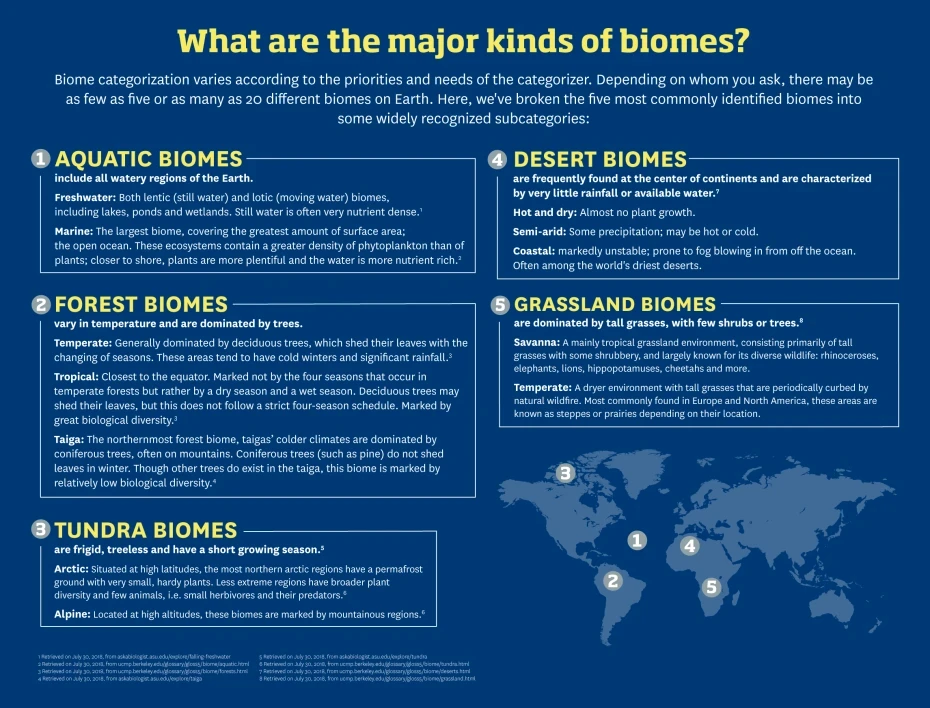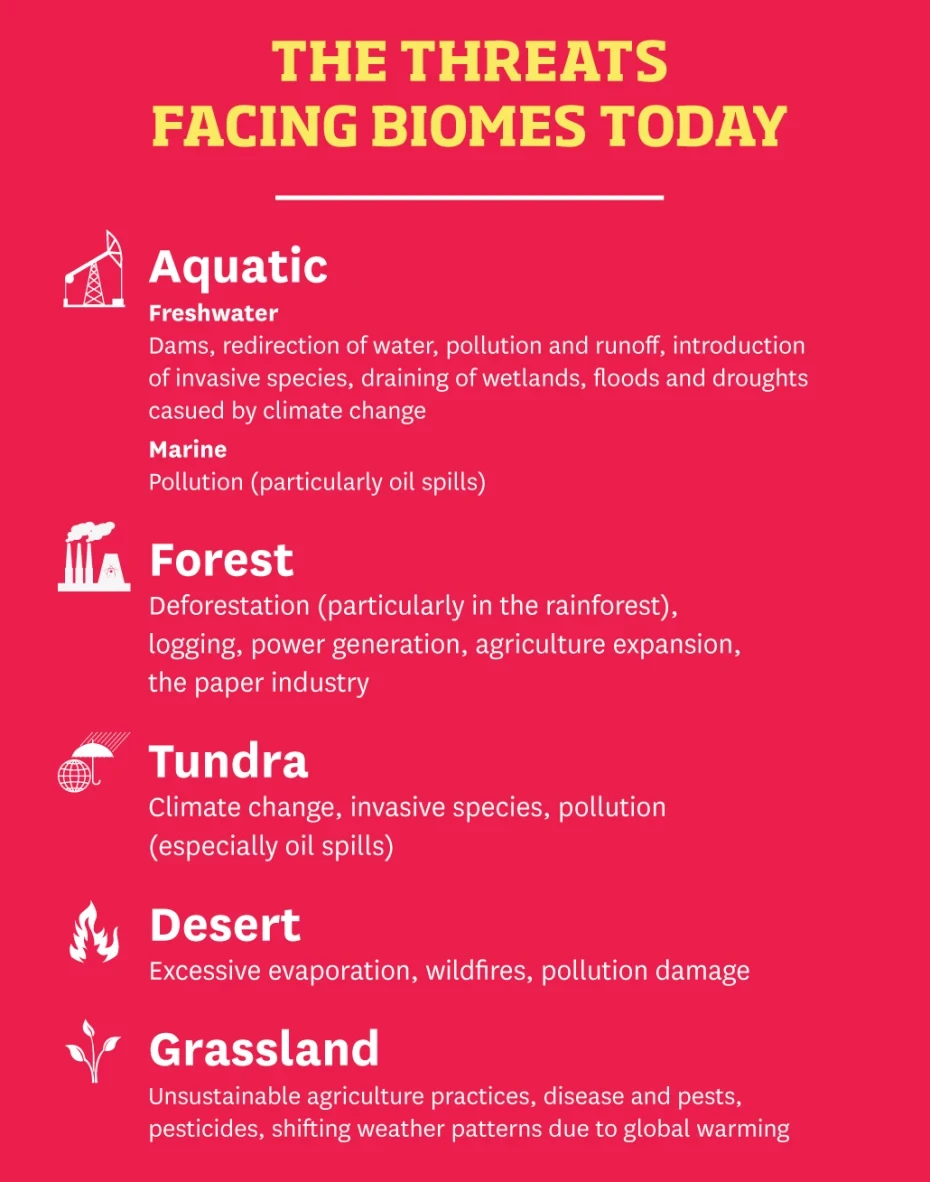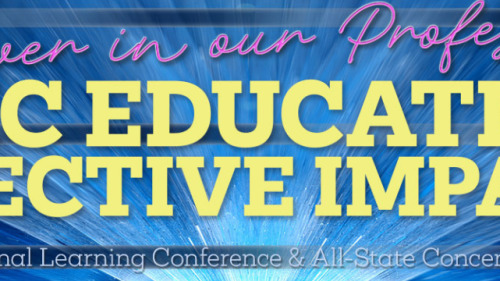Although various fields of science may differ in how they use the word, a “biome” can generally be defined as a geographically large ecosystem with a shared physical climate. Earth’s biomes can be classified broadly into two overarching categories, terrestrial and aquatic. These are further divided based on climate and on the dominant plants and animals that have evolved to thrive in their specific environmental conditions.
Biomes are not restricted to specific geographic regions, and they may not be exclusively inhabited by the same plant or animal species; thus, an individual biome type may appear on multiple continents and feature similar but not identical plants and animals.
Why Categorize Biomes?
We identify different kinds of biomes for the same reason classification systems exist in other areas of science—because breaking down something as enormous as the planet Earth into manageable sections makes it easier for us to understand what we see. Categorizing biomes also helps us identify trends and changes within and between biomes, which can significantly help the scientific community track climate change and determine meaningful ways to pursue solutions.
In contemporary dialogue within the geographical community, anthropogenic biomes are also discussed—those directly shaped by human activity.1 Most places on earth have been, at the very least, indirectly influenced by humans, but anthropogenic biomes have been transformed from their original state to something entirely different. Often, this change has been wrought through human development, such as the construction of concrete roads or the expansion of agriculture, as well as through the introduction of invasive species.
The Threats Facing Biomes Today
Whether directly or indirectly, human intervention has permanently altered the face of our planet. Unfortunately, in many cases, this unchecked human influence has led to dire threats to the overall health of numerous biomes, especially as a result of global warming.
Freshwater biomes face the effects of dams, which redirect water and alter wildlife habitats; withdrawal of water for human use; pollution and runoff from human settlements; invasive species introduced by humans; the draining of wetlands, often to facilitate human development; and floods and droughts brought about by global warming.2 Marine biomes are similarly threatened by pollution, particularly oil spills.
The forest biome most at risk from human development is the rainforest, which has undergone significant deforestation due to logging, power generation, the expansion of agriculture and the paper industry. This massive loss of trees has already contributed to global warming.3
Climate change is the biggest threat to the tundra as temperatures rise and these areas become more hospitable to a wider range of plant and animal life. Animals from other biomes have moved into the tundra and now compete with the native life there, and melting permafrost has resulted in similar changes among plants. Pollution—especially oil spills—has had a disastrous effect on tundra regions as well.4
Deserts are at risk of excessive evaporation, losing what little moisture their systems are currently able to utilize. Due to this unusually dry weather, wildfires threaten to destroy the few plants that grow there more often than they would otherwise. Irrigation by humans has changed the makeup of the soil in desert regions, and oil and gas production, nuclear waste depositing, as well as the presence of vehicles driving through the desert have all caused additional damage.5
Much of the grassland in the U.S. is used for agriculture. Unsustainable practices in the use of this land has depleted its once-rich soil and contributed to the extensive loss of habitat for wildlife, especially avian wildlife. Monoculture crops are at high risk for disease and pests, promoting the use of pesticides that can harm local wildlife and, in turn, disrupt the natural food chain. Additionally, global warming could potentially shift weather patterns that provide the precipitation currently necessary for the survival of grassland regions.6
What Can Be Done to Protect Biomes?
Despite these seemingly dire circumstances, hope is not yet lost. Humans can still reverse some of the damage that has been done to biomes across the globe, or at least mitigate some of its effects, by:
- Prioritizing the protection of wetlands
- Collaborating with farmers and agricultural businesses to improve the use of soil (to retain nutrients, etc.) and to reduce and manage pesticide use. They can also work to plant crops that will restore fertility to the soil in grasslands and desert regions
- Managing controlled burns to help cleanse and rejuvenate grassland biomes
- Restricting dams and other human alterations to aquatic environments
- Constructing ditches in the desert to trap rainfall and seeds, which can promote the natural growth of desert plants (and can in turn anchor the soil to prevent erosion)
- Educating people on sustainable logging practices and purchasing sustainable products
- Combating governmental decisions to cut down trees to build roads
- Cutting greenhouse gas emissions and switching to sustainable, alternative energy sources
- Limiting aggressive human interventions in the tundra, such as mining and road construction
In addition to making environmentally responsible personal lifestyle decisions, you can have a meaningful impact on the world where help is needed the most by choosing from an almost unlimited number of ecologically-focused careers based on your individual strengths. These can include roles in education, scientific research, policymaking and more.
If you are technologically savvy and interested in analyzing environmental data, an online Master of Geographic Information Science (GISc) from Kent State University could help you find your calling. To get started on an exciting career using technology to examine the complexities of the earth’s biomes and human impact on the environment, contact an Admissions Advisor today at 844-234-4073.
Sources:
- Retrieved on July 30, 2018, from sedac.ciesin.columbia.edu/data/collection/anthromes
- Retrieved on July 30, 2018, from nationalgeographic.com/environment/habitats/freshwater-threats/
- Retrieved on July 30, 2018, from nationalgeographic.com/environment/habitats/rainforest-threats/
- Retrieved on July 30, 2018, from nationalgeographic.com/environment/habitats/tundra-threats/
- Retrieved on July 30, 2018, from nationalgeographic.com/environment/habitats/desert-threats/
- Retrieved on July 30, 2018, from nationalgeographic.com/environment/habitats/grassland-threats/







